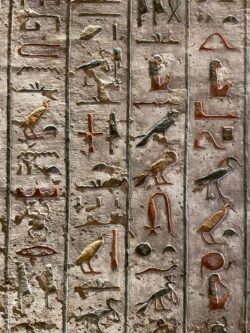Where Did the Alphabet Come From?
 Image by Alex Leon from Pixabay
Image by Alex Leon from PixabayIt appears that our writing system may have been independently invented several separate times because none of the evolving systems shows much influence from the previous ones.
Around 3400–3200 BCE
Merchants needed to keep track of grain, livestock, taxes, and trade.
Sumer (southern Mesopotamia, modern-day Iraq)
System: Cuneiform
The merchants began with little clay tokens to represent commodities (e.g., a cone = a measure of grain). Eventually, they impressed the shapes of those tokens into clay tablets, evolving into wedge-shaped marks made with a reed stylus. The beginning of writing!
Around 3200 BCE
Writing systems then evolved in ancient Egypt in the form of hieroglyphs, only about 250 years after the first examples of cuneiform.
Egypt
System: Hieroglyphics
These hieroglyphics were first pictorial, and then evolved to include phonetic symbols. Hieroglyphics were used for monument inscriptions, religious texts, and administration.
Unlike cuneiform, which leaned toward abstract wedges, hieroglyphs kept their elegant, pictorial style for millennia.
Around 2600–1900 BCE
The Indus Valley Civilization (in modern Pakistan and northwest India) developed a script found on seals and pottery.
It’s short, punchy, and still undeciphered. It is not known if it was a full language, a shorthand system, or just symbolic marks.
Around 1200 BCE
In China, during the Shang Dynasty.
The Shang dynasty set up shop along the Yellow River and wrote early Chinese characters on animal bones during divination rituals.
This writing is found on turtle shells and ox bones and used for divination.
This script is the direct ancestor of modern Chinese characters, an unbroken line of written tradition that’s over 3,000 years old.
Around 1050 BCE
Phoenicians
A consonantal alphabet, stripping down writing to about 22 symbols, making literacy much more accessible.
The Greeks adapted it by adding vowels, leading to what we know as our true alphabet.
The Romans then borrowed from the Greeks, leading to the Latin alphabet, which many languages (including English) use today.
Around 900 BCE
Finally, in Mesoamerica (Mexico and Central America today), writing began to take shape and influenced ancient civilizations like the Aztecs and Maya. Little is known about the history of many of the Mesoamerican languages, because Catholic priests and Spanish conquistadors destroyed a lot of the surviving documentation.
Where did cursive writing come from?
Cursive writing was not invented by one person, but evolved over millennia, with ancient Greeks and Romans using it for speed and efficiency. The term cursive comes from the Latin word for running. Italian scholar Niccolò Niccoli invented the italic style, which forms the basis of modern cursive, in the 15th century, The purpose was to make writing faster and smoother, requiring fewer pen lifts to prevent the quill from drying out or breaking.
Thank you for some of this information: Interesting Facts, article written by Darren Orf and edited by Bess Lovejoy. Check out the website!



